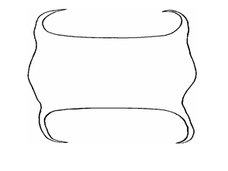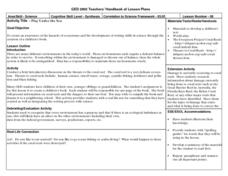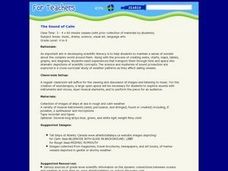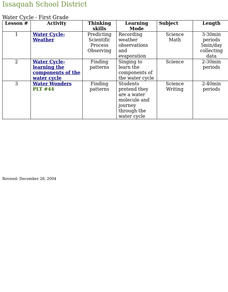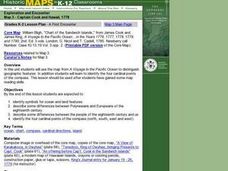Curated OER
Skates
Students gain understanding of structure, characteristics, and basic needs of living things and their role in world, identify parts of skate, observe details of skate's body and skate egg case, and identify unique characteristics of skates.
Curated OER
Trash Traits: Marine Debris, Litter, Ecology, Oceans
Students perform experiments to examine whether trash can float, blow around, or wash away. The effects of these characteristics on the presence of marine debris in the environment are then discussed.
Curated OER
Oceanography Class Quilt
Students create and observe a collage of oceanography topics that be placed on quilt tiles in a culmination art project to represent information learned.
Curated OER
A Tough Neighborhood
Students describe at least three attributes of the deep ocean physical environment that are radically different from ocean habitats near the sea surface.Students explain at least three morphological or physiological adapt
Curated OER
Play Under the Sea
Young scholars explore the hazards of ecosystems and utilize their writing skills to create a studenT book. Threats to the ecosystem of the coral reef are discussed and used as a model for the research of the group.
Curated OER
A Coin Out of Water
Students examine the Michigan state quarter and identify land and water on the quarter. They locate the Great Lakes and other bodies of water on a map. They compare and contrast streams, rivers, ponds, lakes, and oceans.
Curated OER
The Sound of Calm
Students examine the relationships that exist between ocean currents, wind and climate. Using those relationships, they discuss how they affect the oceans. They create their own music to represent the sounds of the ocean and share them...
Curated OER
Oceanography Research
Fifth graders locate information on a specific ocean animal using encyclopedias, nonfiction books, SIRS Discoverer, multimedia encyclopedias, and the Internet. They create an acrostic poem about the ocean animal they have been researching.
Curated OER
Lights in the Deep
Students describe, compare, and contrast bioluminescence, fluorescence, phosphorescence, and chemiluminescence. They explain the role of three major components of bioluminescent systems. They ex
Curated OER
Invent an Invertebrate
Design a new organism with recyclable art materials! After learning about the coastal biome, learners brainstorm challenges that a plant or animal may face. They use their ideas to create a creature, complete with environmental...
Curated OER
How Did This Happen?
Pupils use websites and discussion to investigate the 2004 Asian Tsunami. Students identify the Indian Ocean coastline's physical, political and human geography features and consider how they affected loss of life and property in those...
Curated OER
El Nino
Middle schoolers explain that El Nino is caused by changes in the atmospheric and ocean content.
Curated OER
Anchors Away
Students explore the unique world of the ocean community. They examine cloud formation, habitats and the food chain.
Curated OER
Density Currents
Learners study how fluids of differing densities interact with one another, how densities of fluids can be changed, and how density currents transport and deposit tremendous amounts of sediment in lakes and in the ocean.
Curated OER
A First Encounter
Students identify symbols for ocean and land features, describe differences between Polynesians and Europeans of the 18th century, describe differences between people of the eighteenth century and today, and identify the four cardinal...
Curated OER
Nautical Terminology
Students read excerpts from Gulliver's Travels and note the nautical terminology. While listening to ocean-themed music, students complete worksheets about sea and boat terms and create their own semaphore system. They challenge fellow...
Curated OER
Get Out in the Field
Pupils visit a shoreline--of an ocean, a lake, a pond, a riverbank, etc., survey it and record what they find there. They map the shoreline and surrounding area and conclude where potential waterfront projects could occur.
Curated OER
Discovering the Oasis
Students focus on the types of vegetation and animal life living around local water sources. This lesson can be adapted to any local water source, whether it be a lake, a river, stream or ocean. It has a particular focus on the bird...
Curated OER
Topsy Turvey Tides
Students explore ocean tides. They research how the sun, moon and earth affect the tides. Students draw a diagram illustrating low tides and high tides. They discuss the affect of gravitational pull on the oceans.
Curated OER
Let's Make Waves
Young scholars investigate the concept of waves and how they are formed. The force of wind is demonstrated as the prime factor to the creation of ocean waves. Students research the concept in detail for better comprehension.
Curated OER
Geography Search: The New World
Students explore the "New World". They collect geographic information related to the ocean, latitude and stars, longitude and time, wind patterns, and the weather. They analyze the geographic data and make decisions to plot their...
Curated OER
FRAM: The Most Famous Ship in the World
Seventh graders role play the roles of naval engineer apprentices. In groups, they work together to design a ship which cannot be damaged by freezing ice. They use the internet to research the weather and ocean conditions of the water...
Curated OER
Virginia in the Civil War
Pupils examine the role of Virginia during the Civil War. In groups, they brainstorm ideas about why they believe so many battles took place in Virginia. Using a map, they locate the major battles on land and in the ocean. To end the...
Curated OER
Sailboat Connect-the-Dots Activity
In this math worksheet, students practice counting from 1 to 40 as they connect the dots to make a picture of a sailboat on the ocean. Students color the picture.
Other popular searches
- Oceans
- Oceanography
- Continents and Oceans
- Ocean Currents
- Ocean Mammals
- Ocean Food Chain
- Ocean Explorers
- Ocean Animal Adaptations
- Continents Oceans
- Oceans and Seas
- Ocean Floor
- Oceanography Science
